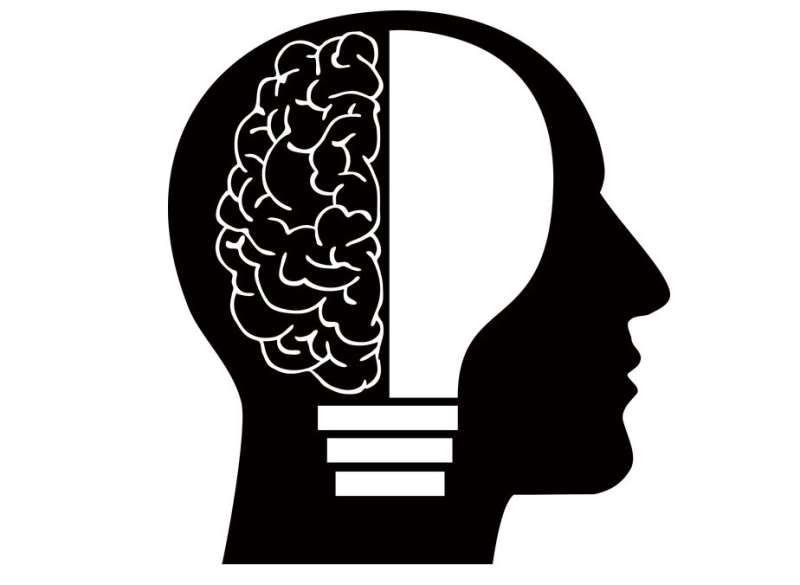July 30, 2019 feature
Researchers model unihemispheric sleep in humans

Some animals, such as birds, dolphins, and whales, can engage in unihemispheric sleep, in which one hemisphere of the brain sleeps while the other hemisphere remains awake. Staying half-awake allows animals to literally "keep an eye open" for predators, and for migrating birds, allows for uninterrupted flight for days or even weeks on end.
Although unihemispheric sleep is not known to occur in humans, recent research has found that humans exhibit a similar sleeping style when they experience troubled sleep in a new location for the first time, called the "first night effect." This effect involves asymmetric dynamics between the two hemispheres: while the right hemisphere engages in normal slow-wave sleep, the left hemisphere experiences shallower sleep, suggesting that it may be staying partially alert.
Now in a new study, researchers have further investigated the underlying mechanisms of this sleep activity in order to develop a model of unihemispheric sleep in the human brain. The paper, by Lukas Ramlow et al., is published in a recent issue of EPL.
"Our research has shown that spontaneous dynamic symmetry breaking of the two brain hemispheres is possible also for humans," coauthor Eckehard Schöll, a professor of theoretical physics at Technische Universität Berlin, told Phys.org. "Since different sleep stages are associated with different degrees of synchronization, I believe that some weak form of unihemispheric sleep, i.e., different sleep depth of the two hemispheres, can well occur in humans, not only in whales, dolphins, seals, and migratory birds."
In the human brain, the sleep and wake states can be distinguished by their different forms of electrical activity. When awake, neurons in the brain fire in an asynchronous, somewhat chaotic fashion, whereas neurons in the sleeping brain fire in a more synchronized manner.
Previous research has suggested that the two hemispheres of the brain can be viewed as two coupled populations of oscillators, as both hemispheres generate electrical signals in a coordinated way. From this perspective, unihemispheric sleep occurs when the brain occupies a state of two coexisting domains, consisting of one synchronized (sleeping) hemisphere and one incoherent (awake) hemisphere. In physics, this type of state, which is characterized by the coexistence of order and disorder, is called a "chimera state."
Using MRI data from 20 humans on 90 different brain sites, the researchers investigated how the brain transitions from incoherence (awake) to synchronization (asleep). As they explain, the coupling within each individual hemisphere (intra-hemispheric coupling) is stronger than that between the two hemispheres (inter-hemispheric coupling). By decreasing the inter-hemispheric coupling strength while keeping the intra-hemispheric coupling strength fixed in their model, the researchers observed that one hemisphere exhibited more synchronized activity than the other, resembling unihemispheric sleep and the chimera state.
"Previously it has been speculated that 'chimera states' may occur in nature in the form of unihemispheric sleep (which is known for certain animals), but no realistic modeling was given," Schöll said. "The significance of our work is that we have shown for the first time by modeling the dynamics of the two brain hemispheres using empirical human brain connectivities that partial synchronization similar to unihemispheric sleep can indeed occur. Moreover, we have identified the mechanism of this relying on different strengths of the intra-hemispheric (strong) and inter-hemispheric (weak) coupling."
The results support the idea that unihemispheric sleep requires a certain degree of separation between the two hemispheres. The researchers found that this separation can occur due to the brain's structural asymmetry. It's well-known, for example, that the two hemispheres have different sizes of corresponding brain regions and different neuronal densities within these regions.
Based on their model, the researchers found that even a slight structural asymmetry results in a dynamical asymmetry, in which one hemisphere exhibits more synchronized firing patterns than the other, as in a chimera state. So overall, the structural asymmetry in the brain may explain the underlying mechanisms of unihemispheric sleep and the related first-night effect, but many questions remain unanswered.
"In future research we plan to investigate more thoroughly the state of unihemispheric sleep in our model (which uses dynamics on empirical structural connectivities of human brains), with respect to the following questions," Schöll said. "Which areas of the brain hemispheres are synchronized, which are not? Can we identify a kind of relay in the brain which mediates synchronization between different areas of the brain? How is such relay synchronization related to memory, or to learning, or to perception? Also, we are investigating how epileptic seizures, which are associated with spontaneous strong synchronization of the brain, can be initiated and terminated."
More information: Lukas Ramlow, Jakub Sawicki, Anna Zakharova, Jaroslav Hlinka, Jens Christian Claussen and Eckehard Schöll. "Partial synchronization in empirical brain networks as a model for unihemispheric sleep." EPL. DOI: 10.1209/0295-5075/126/50007
Journal information: Europhysics Letters (EPL)
© 2019 Science X Network




















